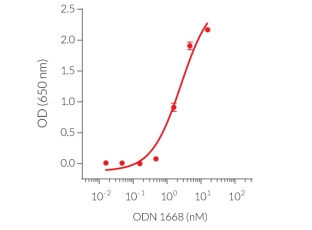ODN 1668
-
Cat.code:
tlrl-1668
- Documents
ABOUT
Class B CpG oligonucleotide - Murine TLR9 ligand
CpG ODN 1668 is a Class B CpG oligodeoxynucleotide widely used to stimulate TLR9-dependent immune responses in murine models. It features a fully phosphorothioate-modified backbone and a strong immunostimulatory CpG motif that potently activates B cells, promoting their proliferation and cytokine production (e.g., IL-6, TNF-α). CpG 1668 is a standard reference in mouse immunology studies, particularly in vaccine research, B cell function assays, and TLR9 pathway characterization.
All products are for research use only, and not for human or veterinary use.
SPECIFICATIONS
Specifications
5’-tccatgacgttcctgatgct-3’
1-5 µM
5 mg/ml in water
TLR9 activity tested using HEK-Blue™ TLR9 cells, absence of bacterial contamination confirmed using HEK-Blue™ TLR2 and TLR4 cells
CONTENTS
Contents
-
Product:ODN 1668
-
Cat code:tlrl-1668
-
Quantity:200 µg
1.5 ml sterile endotoxin-free water
ODN 1668 is provided lyophilized
Shipping & Storage
- Shipping method: Room temperature
- -20°C
- Avoid repeated freeze-thaw cycles
Storage:
Caution:
DOCUMENTS
Documents
Technical Data Sheet
Validation Data Sheet
Safety Data Sheet
Certificate of analysis
Need a CoA ?
